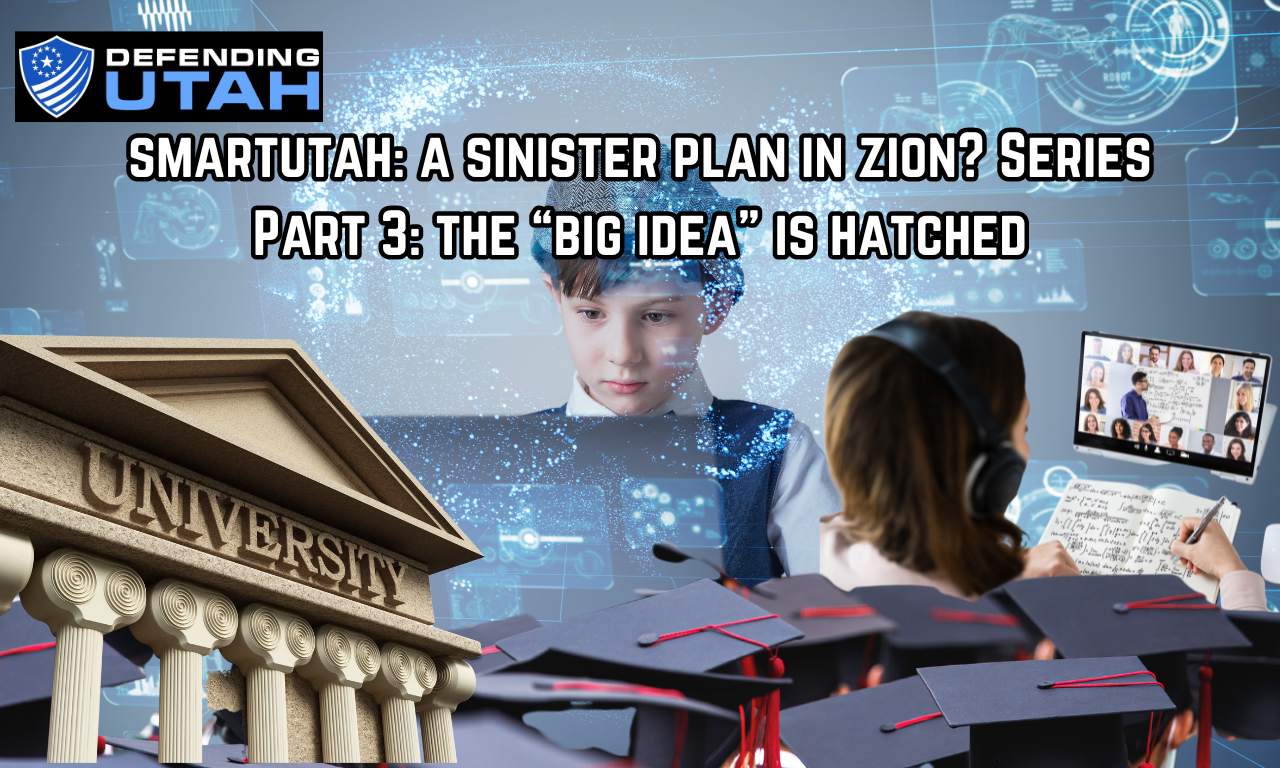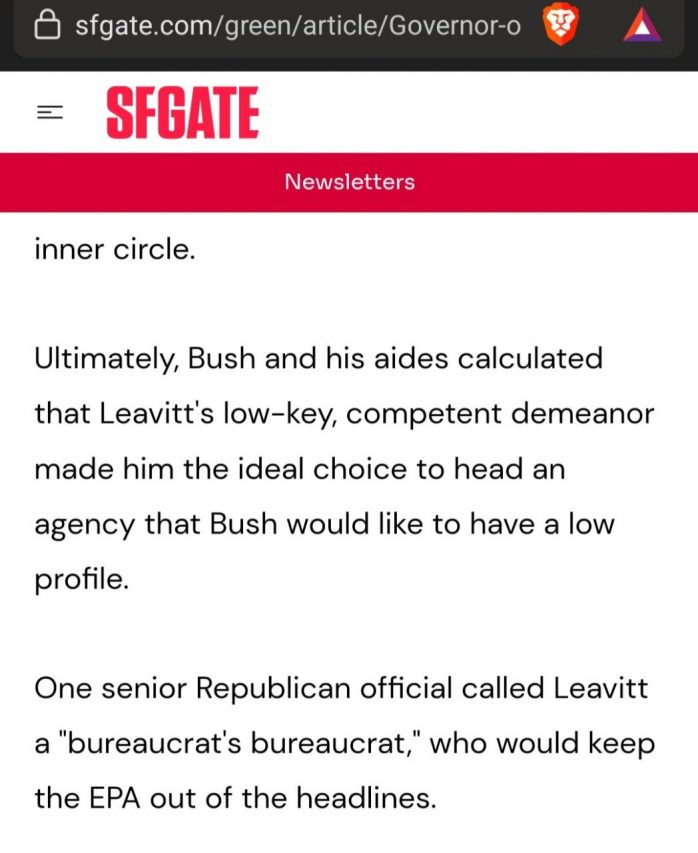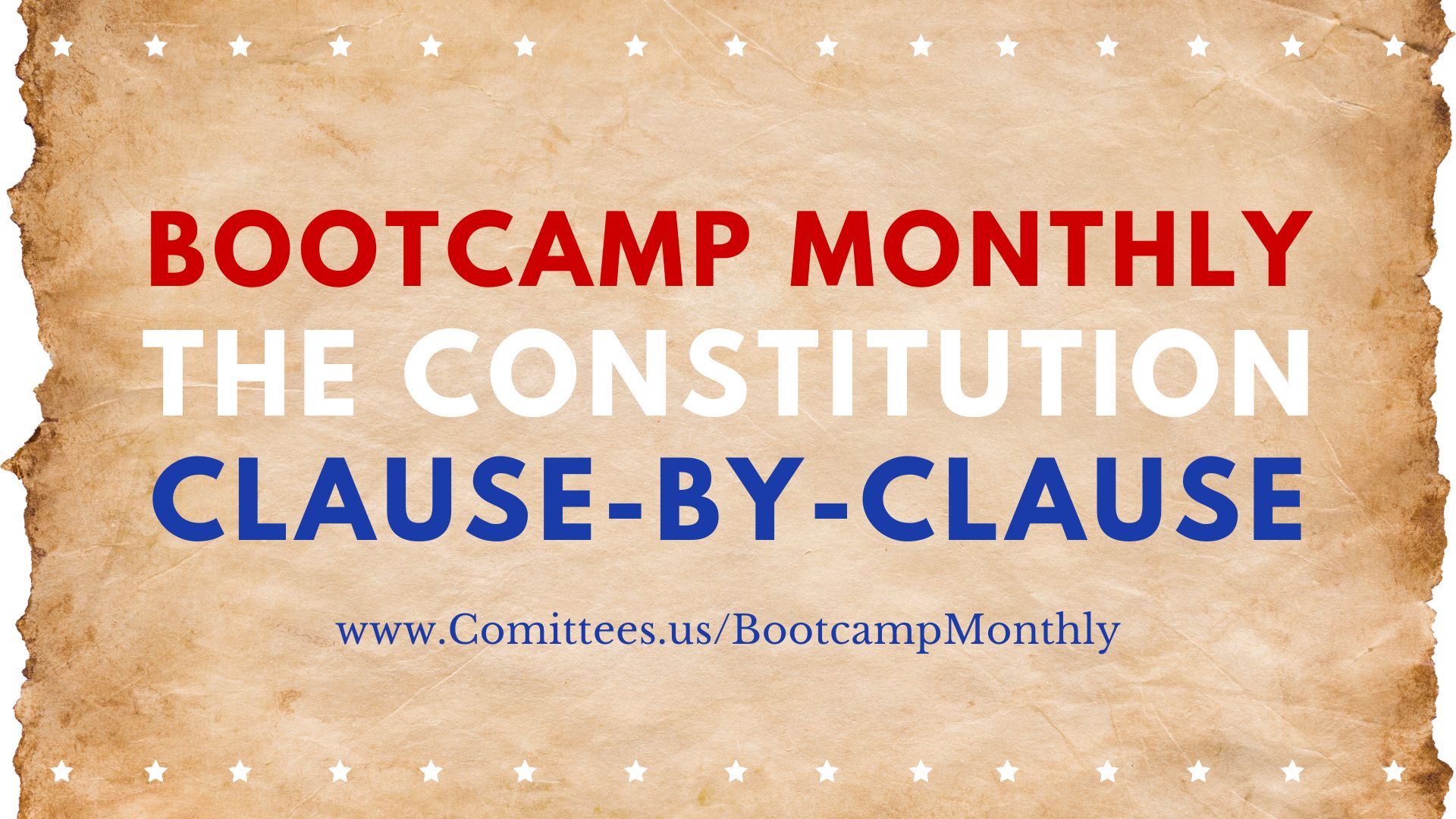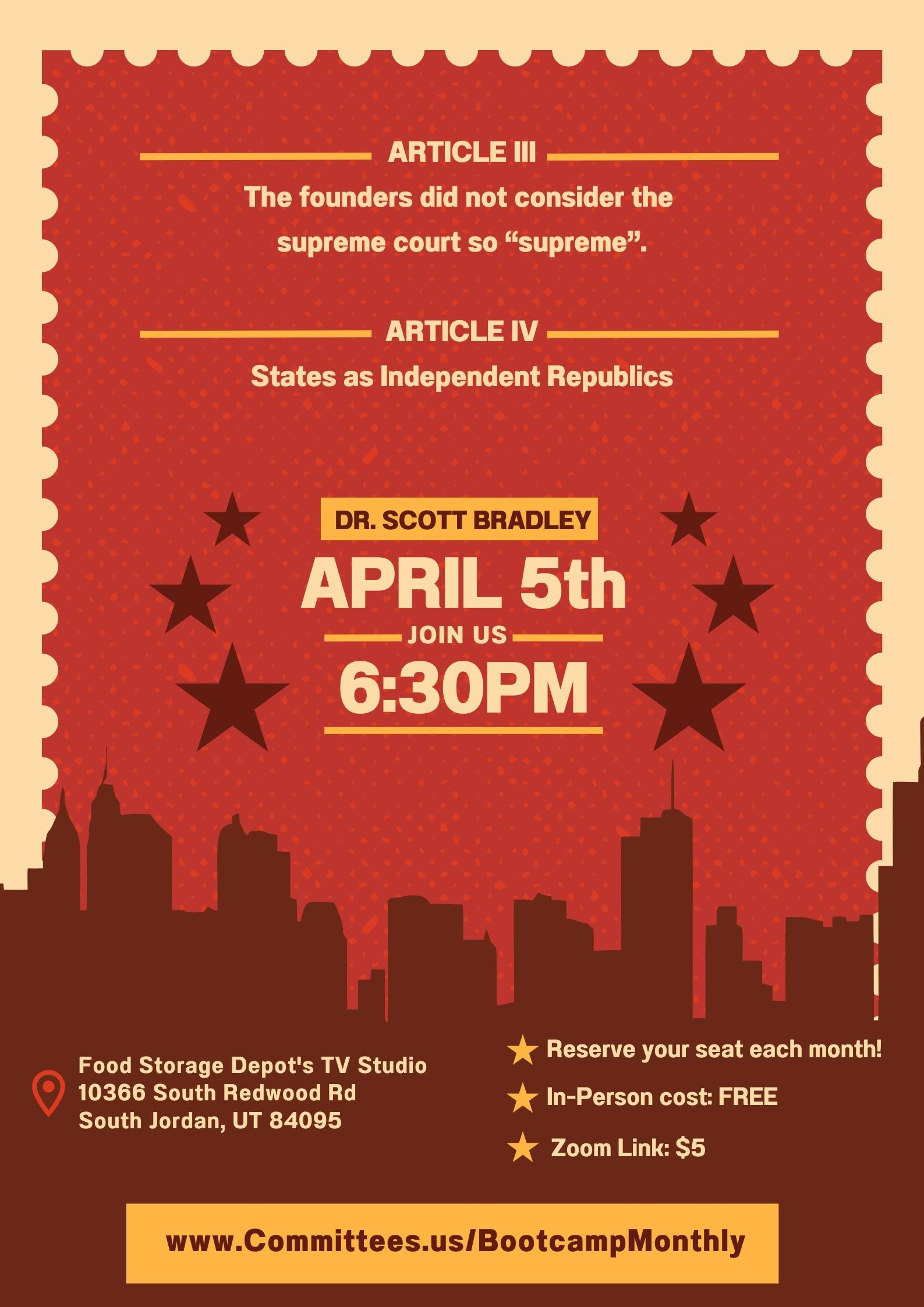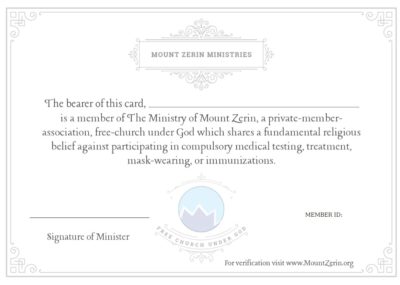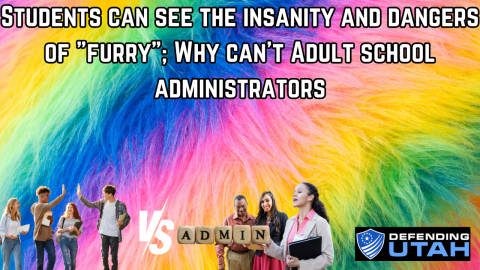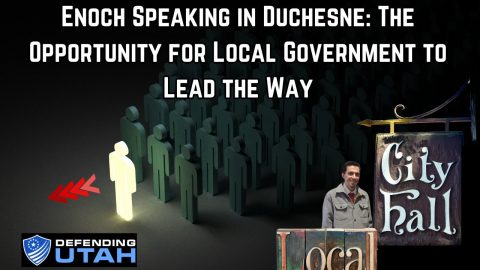SMART UTAH PART 3
Hopefully you have read part 1 and part 2. We are going to pick up where we left off – “Establishing a SmartUtah Brand.”
Now, you may have heard of “smart growth,” “smart homes,” and “smart cities” among others, but did you know there was (probably under anew name) a “SmartUtah” program?
Let’s go back to 1994, when Mike Leavitt was the sitting governor in Utah. Many of us in Utah, me included, thought Leavitt was a great guy. Just a regular guy, a neighbor, one of us. I didn’t look beyond the basics really, and he was getting pats on the back here and there, promotions etc. To a “normie” he appeared great for Utah, but was he?
As I did my research on Utah and smart states, smart cities etc, I ran across a document that blew my mind. THE ORIGIN, DEVELOPMENT AND IMPLICATIONS OF THE WESTERN GOVERNORS UNIVERSITY by Kevin Kinser. This was published in 1999. In 2000 an audit was done, so keep that date in the back of your head.
This document is a hefty 249 pages long, and it’s one of several documents that dig into “smart” or the tech boom in Utah.
Below is a screenshot where we learn Leavitt decided to “inaugurate a business-government partnership called SmartUtah.” It’s clear from the screenshot below it was to push the tech sector in Utah, and the reason he said was economics. That could all be true, but I wanted to briefly point out a few issues that should be note here.
- Sustainable- this word on its own is not a problem. In fact, its meaning is a good one. One thing I have learned after looking at all of this, is there are groups in Utah and all over the world very good at using manipulative language to push their agenda. Sustainable for them means restricted, controlled, and limited. The goal is to limit the population, not themselves.
- Global marketplace- Again on its face it’s fine, even desired. The issue comes in again with what we have learned. Being “global” doesn’t mean we’re all helping one another out. Instead, it appears to mean countries are aligning to self-destruct and usher in an elite few to exert control over the entire planet.
- Public and Private- Utah has a major problem with either not fully understanding what public private partnerships (PPP) are, or they are willingly signing up for it. It’s not constitutional and it leads to exactly what we are seeing- technocracy.
- Utah is an “anchor tenant.” Utah tends to be a “founding,” or “anchor,” or “pilot” for a lot of questionable programs. Why are we jumping in first? First is not always better.
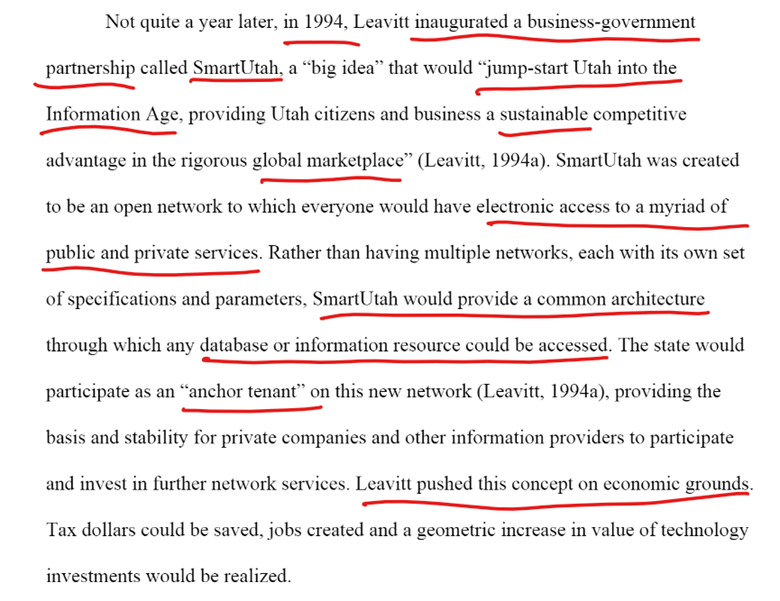
Now, how did they plan on executing this “big idea” and getting other states on board?
Leavitt got Colorado’s governor on board and the two of them proceeded to pull in every single other governor.
Below is a direct quote:
“Connecting his initiatives with technology in the Utah state government to this idea, he began to envision a multi-state version of SmartUtah: SmartStates. It would be a way of sharing information and resources among states using technology. It would allow economies of scale and help prevent each state from having to reinvent the wheel for each new, expensive, information technology project. Like SmartUtah, it would be a partnership between government and industry to develop standards and applications that would be usable across the network. Some of these things were happening with the health and welfare projects that Leavitt had already initiated through the WGA (Western Governors Association, 1995a), but the focus of those projects had always been rather narrow. SmartStates was a way of tying together disparate pieces, providing a broad framework for integrating and coordinating work being done to make a host of regional government services more efficient and less duplicative (Western Governors Association, 1998a).”
Lots to unpack here, but the biggest red flag is that last sentence. Framework and coordination (again harmless words when there is nothing questionable behind them) means centralized government in this case. This is shifting over to a hybrid between communism and corporate fascism. Worse, it’s not just Utah he’s pushing this in and on, it’s the entire country.
Now remember I highlighted 1992 as important in part 1. The reason is because the SmartUTAH PPP happened in 1994. Look at how quickly we went from having a SMART phone to a country wide plan for implementation of SmartStates.
WESTERN GOVERNORS UNIVERSTIY
Higher education was deemed as the vehicle to implement this across the United States. SmartUtah, QGET (Quality Growth Economic Toolset), Western Governors (WGU), and what is now known as Envision Utah linked up to push the technology agenda. We will go over this more in a following post, but an audit of these groups together was very enlightening.
“The implementation plan approved in Omaha described two visions, three missions, four benefits, five roles, and 16 activities for the WGU. In this jumble, and mixed throughout the governors’ rhetoric, several themes kept reappearing which can be thought of as portraying the original goals of the WGU” all with advanced technology central to the process:
- Improving access to education and reducing its cost
- Encouraging competency-based degrees
- Changing higher education
This was
“…a big idea, as Romer was fond of saying (Western Governors Association, 1996h). Higher education could be organized, delivered, and assessed in ways that were dramatically different, and significantly less expensive, than traditional methods. Rather than just issuing a report that made these bald assertions, however, the governors approved an implementation plan to bring them to fruition. The WGU was their chosen instrument of public policy. As the WGU moved from the rhetoric of vision statements and implementation plans, the reality of creating an actual university required the assistance of people with expertise in the design and delivery of academic programs. And the governors generally did not look too far outside the box for these individuals.”
Like any massive new project, it went through some changes and reality checks. Below is a quote about some of those, but something specifically caught my attention “…However, despite such significant adjustments to the original vision, the “fundamental revolution” of the WGU as it was initially conceived by Leavitt and Romer (Western Governors Association, 1995b) remained intact.”
Fundamental revolution is quite alarming. Utah Freedom Coalition did a 3-part series breakdown of just the tip of the iceberg on the United Nations infiltration of our higher education schools. So, let’s break down the quote below:
“The effect of this on the development of the WGU was evident through three main changes which took place.
Promoting the role of advanced technology in the academic activities of traditional colleges and universities became less important to the broader mission of the WGU.
Within the original set of goals, the cost-savings rationale was de-emphasized, while the institution’s mission of providing competency-based learning and improving access to education was highlighted.
Those involved in developing the WGU began to back away from the notion that the institution was going to force a wholesale change in traditional higher education. However, despite such significant adjustments to the original vision, the “fundamental revolution” of the WGU as it was initially conceived by Leavitt and Romer (Western Governors Association, 1995b) remained intact.”
Now what exactly does that all mean? I will try to explain below:
Technology
Most appear to have jumped on board with Leavitt’s SmartStates initiative. The original name for the initiative was Western Virtual University, and its logo was a floppy disk and CDROM. The name was changed when the vision shifted.
Below are some screenshots for you that give some further information on this.
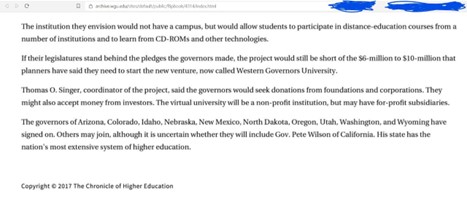
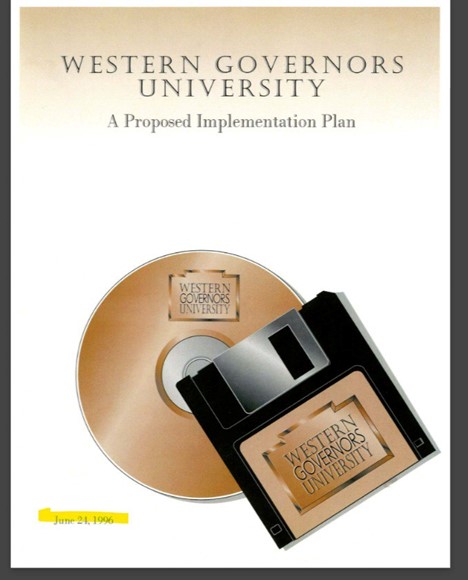
In a Las Vegas meeting where the idea was first publicly presented it was entitled “Higher Education and Information Technology.”
“The name change, though made ostensibly for the sake of public relations, was the beginning of a more fundamental re-adjustment for the WGU. The vision statement originally argued that the new university was necessary to provide “incentives” so that technology would be “more widely adopted” by traditional colleges and universities (Western Governors Association, 1996b). Now, however, those implementing the governors’ vision recognized that this technological focus was tangential to the WGU’s core activity of operating as a university in its own right. The technology policy agenda began to be pushed aside as the institution developed. ‘Virtual’ was first to go, followed by the governors’ futuristic accounts of the power of technology to replace the campus.”
So, what did the new vision entail?
“Since the WGU did not represent an expansion of distance education, it could present a more moderate image to traditional academia. And by toning down the high-tech talk, the WGU organizers felt they could fend off much of the criticism from academics who were made nervous by the earlier technological proselytizing. By only focusing on those institutions and faculty which were already involved in distance learning, it made the WGU seem all the more reasonable as an option. As one consultant put it, “It’s hard to say this is really crazy if they’re involved in doing it themselves” (Interviews).”
While the intent may not have been quite as stark as this, the choice of action and even language used in several quotes from WGU appears to knowingly manipulate people into going along with something they otherwise would not. Looking back, knowing what we know now, those who were nervous had every right to be and were likely correct. Technology certainly has offered some amazing progress but does the good outweigh the bad? I’m not sure it does. Let Defending Utah know what you think.
More than all of that though, is the issue of being transparent and honest. How can people make real choices based on manipulated representations?
A quote about Leavitt’s ability to use interesting language to lead the public.
“So how do you build a positive image when professional environmental groups have already tagged you as public enemy number one? Well, one strategy is to make sure the federal agencies who act as watchdogs of the environment are headed by people who can “talk a good game”. Bush seems to have employed that strategy by appointing Utah governor Mike Leavitt to head the Environmental Protection Agency (EPA).” Source: NewScientist
Cost Savings Were De-emphasized
As they state they decided to “de-emphasize” cost savings, but why?
“What became clear, however, was that the emphasis on saving money called into question the governors’ commitment to educational quality (Interviews). This was, in fact, a common sentiment held by many of the WGU’s critics. “Quality is never cheap,” was how one higher education leader put it (Interviews). Another stated that, in his opinion, the strongest motivation driving [the WGU] has been saving money. The motivations of the leaders — the governors of the states — typically their motives are not high handed or at a high-level, in the sense of wanting to serve more students or improve quality. [The governors] want to do this at less cost so that [they] can spend money on other priorities. They are not blind to the costs of say, the British Open University, which has its costs driven down to, I don’t know, something like five hundred dollars per FTE or something like that. And so, they look at those kinds of things and conclude, wow, let’s get kicking here and let’s get something put together. And so, I do have a certain concern about the way it will all be carried out, because of what I perceive the motives to be. (Interviews)”
Again, looking back this person was likely correct to question. So, what did they do about these concerns?
They may have received push back because each state wanted to preserve the big money and campus football stadium, not centralize money and control in a virtual university. So they backpedaled.
“The implementation team responded the same way to this concern as they did when they met with resistance to the emphasis on technology. They simply changed the focus. “When the possibility of saving money was mentioned, it was often with a caveat: “The WGU should not be expected to, nor indeed should it, reduce state support for higher education; rather, the funds expended will be more efficiently used.”
“Other presentations by the WGU staff would phrase the same point as “minimizing the costs of replication and duplication,” discussing it almost exclusively in terms of “cost-effectiveness” and “Cost-effective as a descriptor actually went back to the vision statement. In that document it was defined as “sharing information technology infrastructure, seeking other economies of scale, forging partnerships, drawing on existing educational resources, and reducing time to degree to the fullest extent possible to reduce the per-student costs of delivering instruction.”
Ultimately, they landed on variations of this, “The idea was not that tuition would necessarily be lower, however. Rather costs would be reduced “because the student doesn’t have to travel and move.” There was also a big push to highlight “competency based.” Thus, removing the need for a physical classroom. As evident from the quote below:
“Instead of the goal of saving money, then, the implementation team emphasized the more educationally oriented goals of improving access and promoting competencies as the rationale for the new institution.”
Back to virtual school without calling it a virtual school. Something interesting to note is this quote from the paper, which when you put this in scope of a post COVID-19 population rings even more accurate now. They continued to get push-back:
“If you are educating on-campus, the likelihood of student-peer interaction is much greater. And we know from all the educational literature that that matters. The likelihood of access to, and assignments in, a library is much greater. And we all know that that matters. The likelihood that faculty will have and keep office hours, and that students will interact with them there is much greater. And we know that that matters. So, there are a host of differences, none of which is decisive. That is, these are process things, and they don’t guarantee a good outcome, but if I’ve got one education system that is doing them all, and another one that is not, it seems to me then there is more to prove about the one that is not. (Interviews)”
This leads us to the most concerning of the 3 goals, “fundamental revolution” of our education system.
Fundamental Revolution of Education
I pulled a large chunk of text from the paper THE ORIGIN, DEVELOPMENT AND IMPLICATIONS OF THE WESTERN GOVERNORS UNIVERSITY by Kevin Kinser because I can’t say it any better. This should send off some alarm bells, especially with how higher education has turned out.
“The remaining original goal for the WGU was for it to change higher education.
The adjustments made to this goal, however, reflected neither the quality emphasis nor a refinement of educational goals. Rather this goal was modified more out of an interest in making colleges and universities partners in the enterprise.
Governor Nelson insisted on this partnership as part of the implementation plan. And WICHE’s Cooperative was itself an organization made up of institutions in a partnership, with Sally Johnstone, the Cooperative’s director, a member of the design team and a major contributor to the planning process.
The polemics against traditional institutions would have to stop and a more moderate rhetoric would have to take its place if the WGU was going to be taken seriously in this partnership agenda. That was exactly what happened.
Two speeches by Governor Romer (1996; 88 1997), presented eight months apart, gave a sense of the difference.
In the first speech, for a meeting of the National Association of State Universities and Land Grant Colleges (NASULGC), Romer stated that “higher education has not kept pace” with the changing demands of a skeptical public.
He continued with a bulleted list of “reasonable” concerns that he and the public shared. Some examples:
- … Classes that cram hundreds of students into a lecture hall [and] academic calendars that seem to offer as much vacation time as class time…
- Professors that entrench themselves behind the walls of the institution and lose touch with the evolving world outside the campus…
- Tuition rates that don’t correlate with inflation or demonstrable improvements in the educational product. And … more and more students [having] difficulty finding a relevant and meaningful job after they finish school. (Romer, 1996)
The second speech, given at a meeting of the American Association of Collegiate Registrars and Admissions Officers (AACRAO) had a rather different bent.
The bullet points were gone and in their place was this paragraph: We must push higher education to raise its sights — we should always seek to raise the quality of our most important investments. We cannot rest on the laurels of a past reputation. While I know there is so much right about our higher education systems, there is always room for improvement and innovation. (Romer, 1997)
Further evidence of the change is contained in the conclusions of the two speeches. The later AACRAO speech, after describing the WGU, offered this summary: The Western Governors University is a big idea. It will give students greater choice and access in higher education. As a practical matter, this means we are going to offer a high-quality education to many more people. I encourage all of you to think creatively about how this initiative fits with the work you are currently involved in at your institution. (Romer, 1997)
The 1996 NASULGC speech had the exact same conclusion, with one significant difference. Inserted immediately before the last sentence was the following: “The Western Governors University has the potential to dramatically alter the way education is delivered in Colorado and throughout the western region” (Romer, 1996)”
And boy did it!
Not only do we have a large portion of our population “learning” online, but we have a global agenda being promoted, pushed, and in some cases mandated. Utah’s very own Utah Valley University may as well change their name to Utah United Nations University.
Defending Utah reported in 2018 how the UVU became an official propaganda arm of the United Nations.
Not only have these universities promoted the SDG goals in a broad general way, they’ve doubled down.
Think I’m making it up? Well check the below out:
UVU hosting the 1ST INTERNATIONAL ACADEMIC CONFERENCE ON THE SUSTAINABLE DEVELOPMENT GOALS- “WHY IT MATTERS” AS PART OF THE DECADE OF ACTION.
This was just last year. This is extremely alarming. Not only are we paying for this we are sending our kids to a school promoting a FOREIGN, UNELECTED, APPEARS TO BE HOSTILE, ORGANIZATION.

Now I want to show you something that was sent to me via another group that made my jaw hit the floor.
This is from the United Nations website.
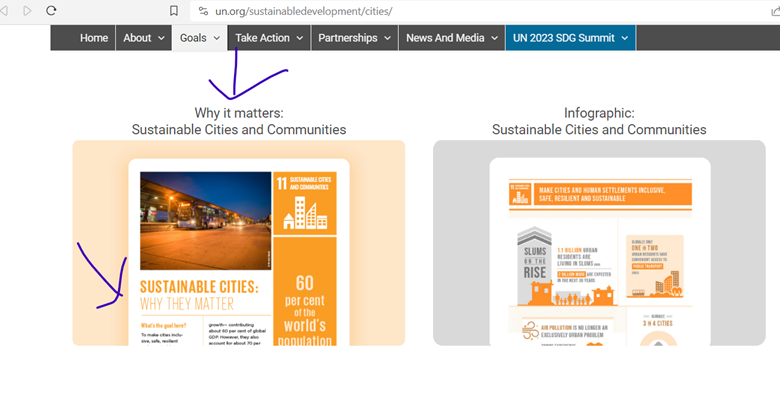
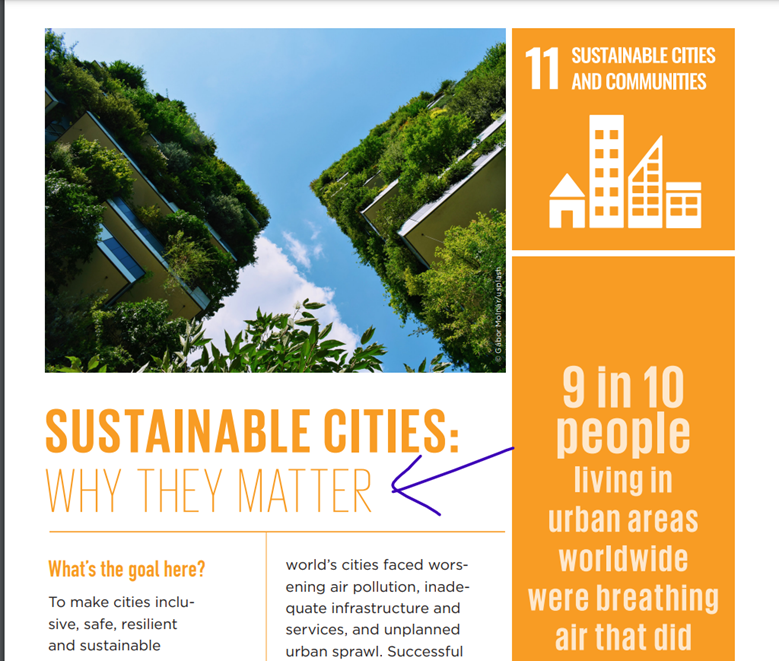
Every single goal has this highlight. Why is a school in Utah writing Volume I and II on a UN SDG Goals “Why they matter?” Each of those documents are around 800 pages long. They even have a YouTube channel.
Every single mainstream higher education school has a model UN program, and worse. Our Children K-12 are being taught United Nations curriculum. This was recently given unlimited funds- no cap. https://www.niche.com/k12/search/schools-with-ib-program/s/utah/
Did you know:
IB is the capstone program of UNIS which stands for United Nations International School.
The Utah board (not all members) recently voted to remove the $100K cap on the IB program in Utah so it can be expanded.
In addition to the IB program being aligned to UN 2030 SDG goals, it is also pushing a DEI, CRT, Social Justice narrative.
Utah was targeted for many reasons, but one of the biggest… YOUR KIDS!
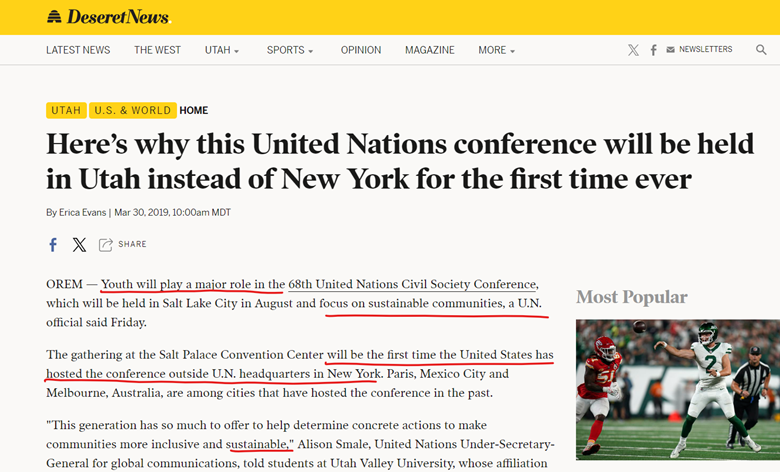
I will leave it there until next time.
See our full reports on the 2019 United Nations conference at www.UnitedNationsUtah.com
In our next segment we’ll go over some interesting ties to “SmartUTAH” and more.
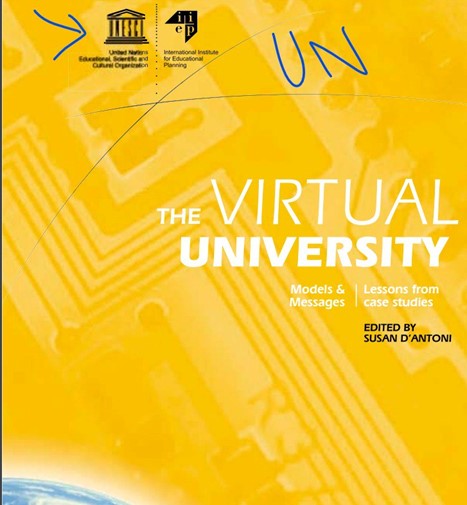
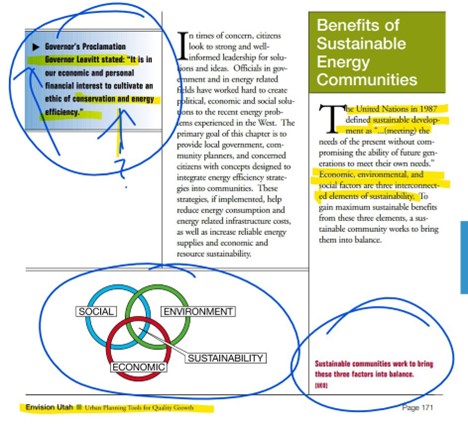
Source: Envision Utah Urban Planning Tools for Quality Growth

